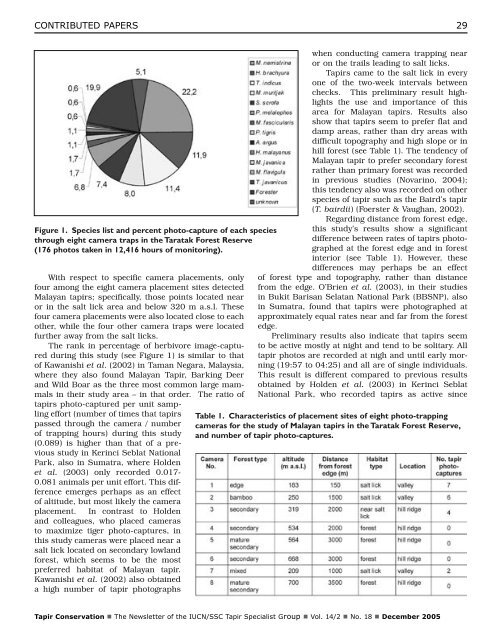Tapir Conservation - Tapir Specialist Group
Tapir Conservation - Tapir Specialist Group
Tapir Conservation - Tapir Specialist Group
You also want an ePaper? Increase the reach of your titles
YUMPU automatically turns print PDFs into web optimized ePapers that Google loves.
CONTRIBUTED PAPERS<br />
Figure 1. Species list and percent photo-capture of each species<br />
through eight camera traps in the Taratak Forest Reserve<br />
(176 photos taken in 12,416 hours of monitoring).<br />
With respect to specific camera placements, only<br />
four among the eight camera placement sites detected<br />
Malayan tapirs; specifically, those points located near<br />
or in the salt lick area and below 320 m a.s.l. These<br />
four camera placements were also located close to each<br />
other, while the four other camera traps were located<br />
further away from the salt licks.<br />
The rank in percentage of herbivore image-captured<br />
during this study (see Figure 1) is similar to that<br />
of Kawanishi et al. (2002) in Taman Negara, Malaysia,<br />
where they also found Malayan <strong>Tapir</strong>, Barking Deer<br />
and Wild Boar as the three most common large mammals<br />
in their study area – in that order. The ratio of<br />
tapirs photo-captured per unit samp-<br />
ling effort (number of times that tapirs<br />
passed through the camera / number<br />
of trapping hours) during this study<br />
(0.089) is higher than that of a previous<br />
study in Kerinci Seblat National<br />
Park, also in Sumatra, where Holden<br />
et al. (2003) only recorded 0.017-<br />
0.081 animals per unit effort. This difference<br />
emerges perhaps as an effect<br />
of altitude, but most likely the camera<br />
placement. In contrast to Holden<br />
and colleagues, who placed cameras<br />
to maximize tiger photo-captures, in<br />
this study cameras were placed near a<br />
salt lick located on secondary lowland<br />
forest, which seems to be the most<br />
preferred habitat of Malayan tapir.<br />
Kawanishi et al. (2002) also obtained<br />
a high number of tapir photographs<br />
<strong>Tapir</strong> <strong>Conservation</strong> n The Newsletter of the IUCN/SSC <strong>Tapir</strong> <strong>Specialist</strong> <strong>Group</strong> n Vol. 14/2 n No. 18 n December 2005<br />
29<br />
when conducting camera trapping near<br />
or on the trails leading to salt licks.<br />
<strong>Tapir</strong>s came to the salt lick in every<br />
one of the two-week intervals between<br />
checks. This preliminary result highlights<br />
the use and importance of this<br />
area for Malayan tapirs. Results also<br />
show that tapirs seem to prefer flat and<br />
damp areas, rather than dry areas with<br />
difficult topography and high slope or in<br />
hill forest (see Table 1). The tendency of<br />
Malayan tapir to prefer secondary forest<br />
rather than primary forest was recorded<br />
in previous studies (Novarino, 2004);<br />
this tendency also was recorded on other<br />
species of tapir such as the Baird’s tapir<br />
(T. bairdii) (Foerster & Vaughan, 2002).<br />
Regarding distance from forest edge,<br />
this study’s results show a significant<br />
difference between rates of tapirs photographed<br />
at the forest edge and in forest<br />
interior (see Table 1). However, these<br />
differences may perhaps be an effect<br />
of forest type and topography, rather than distance<br />
from the edge. O’Brien et al. (2003), in their studies<br />
in Bukit Barisan Selatan National Park (BBSNP), also<br />
in Sumatra, found that tapirs were photographed at<br />
approximately equal rates near and far from the forest<br />
edge.<br />
Preliminary results also indicate that tapirs seem<br />
to be active mostly at night and tend to be solitary. All<br />
tapir photos are recorded at nigh and until early morning<br />
(19:57 to 04:25) and all are of single individuals.<br />
This result is different compared to previous results<br />
obtained by Holden et al. (2003) in Kerinci Seblat<br />
National Park, who recorded tapirs as active since<br />
Table 1. Characteristics of placement sites of eight photo-trapping<br />
cameras for the study of Malayan tapirs in the Taratak Forest Reserve,<br />
and number of tapir photo-captures.










